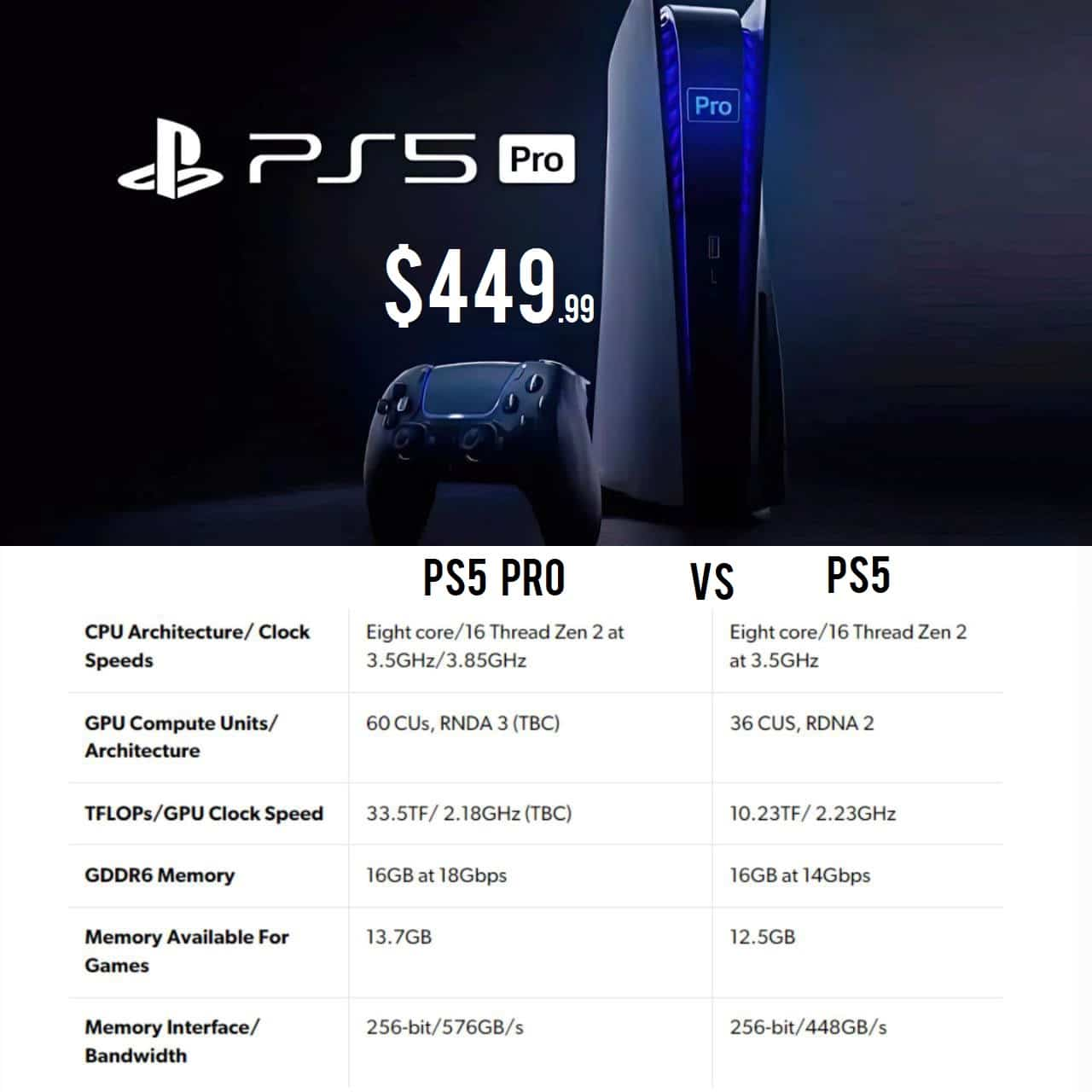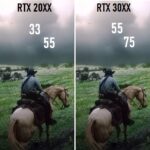Let’s delve into the intricacies of the CPU upgrade in the highly anticipated PlayStation 5 Pro, exploring its implications for gaming performance and future developments.
Understanding the CPU Upgrade
Looking back at the PlayStation 4 Pro, one of its limitations was its CPU, which mirrored that of the base PlayStation 4 with a mere clock speed enhancement. This restricted the console’s capability for high frame rate gameplay and hindered potential advancements in physics-based gaming experiences.
Now, with the PlayStation 5 Pro on the horizon, we encounter a similar narrative. The CPU remains unchanged from the original PlayStation 5, featuring the same Zen 2 architecture. However, there’s a twist – the PlayStation 5 Pro introduces two operating modes for its CPU. The standard mode maintains a maximum clock speed of 3.5 GHz, while the enhanced mode boosts this frequency by 10%, reaching a maximum of 3.85 GHz.
Implications of the CPU Upgrade
While the CPU upgrade seems modest, it bears significant implications for gaming performance. The enhanced mode offers a marginal improvement in CPU performance, primarily benefiting titles that are CPU-limited. However, for games targeting 30 FPS, the impact may not be revolutionary.
Developers face the challenge of optimizing games for the console’s CPU limitations. While the PlayStation 5 Pro boasts a powerful GPU, its CPU may pose constraints, especially for titles incorporating advanced physics and AI features.
Factors Influencing the CPU Decision
Several factors contribute to the decision to retain the Zen 2 architecture in the PlayStation 5 Pro. Firstly, compatibility and ease of development play a crucial role. Sticking with Zen 2 ensures consistency in development environments and avoids complicating game development processes.
Additionally, power consumption considerations may have influenced the decision. The fixed power cap of the console necessitates a balance between CPU and GPU performance. Any significant increase in CPU clock speeds could potentially impact GPU performance, leading to trade-offs in overall gaming experience.
Future Prospects and Considerations
Looking ahead, the PlayStation 5 Pro’s CPU upgrade sets the stage for future gaming experiences. While it may not deliver groundbreaking improvements, it ensures compatibility and stability in game development. Developers must leverage the console’s capabilities effectively, optimizing games to deliver immersive experiences within the constraints of the CPU architecture.
As the gaming landscape evolves, innovations in CPU technology may pave the way for enhanced gaming experiences. However, for now, the PlayStation 5 Pro’s CPU upgrade offers incremental improvements while maintaining compatibility and stability in game development.
Let’s dive into the advancements and intricacies of the GPU in the upcoming PlayStation 5 Pro, exploring the implications of its architecture and performance enhancements.
The GPU Upgrade: A Significant Leap Forward
With the PlayStation 5 Pro, gamers can expect a substantial leap in GPU performance. The console is poised to transition from 36 compute units to 60, marking a notable increase in raw compute power. Additionally, there’s a remarkable enhancement in memory bandwidth, approximately 25.5%, which is crucial for supporting high-resolution textures and complex gaming environments.
Decoding Teraflops: Beyond the Numbers
Teraflops have been a focal point of discussion, with Sony boasting a significant increase from the original PlayStation 5. However, it’s essential to understand that teraflops alone don’t paint the full picture of gaming performance. Sony acknowledges this, stating that the 33.5 teraflops of the PlayStation 5 Pro translate to approximately 45% extra performance in existing games.
Dual-Issue FP32: Distorting Teraflops and Real-World Performance
The PlayStation 5 Pro’s architecture introduces dual-issue FP32 operations, inflating theoretical teraflops performance. While this may seem impressive on paper, it’s crucial to consider real-world gaming scenarios. In practice, the impact on overall frame time and gaming performance may not align with the inflated teraflops figures.
GPU Clock Speeds and Form Factor Considerations
Sony’s decision to maintain a slightly lower clock speed for the PlayStation 5 Pro’s GPU raises questions about compatibility and form factor. The wider GPU architecture coupled with a modest clock speed suggests potential challenges in thermal management and power consumption. It remains to be seen how Sony will address these concerns while optimizing performance and form factor.
Cost-Efficient Solutions and Future Developments
Sony’s approach with the PlayStation 5 Pro reflects a shift towards cost-efficient solutions amidst technological constraints. Rather than relying solely on transistor count for performance boosts, Sony emphasizes software optimization and architectural enhancements. This aligns with industry trends, where innovation in software and AI-driven technologies plays a pivotal role in unlocking the full potential of gaming hardware.
Looking Ahead: The Promise of Enhanced Gaming Experiences
As the PlayStation 5 Pro prepares to make its debut, gamers can anticipate a more immersive and dynamic gaming experience. While hardware specifications provide a glimpse into the console’s capabilities, the true measure of its success lies in its ability to deliver compelling gaming experiences. Sony’s strategic balance of hardware enhancements and software optimization sets the stage for a new era of gaming innovation.
Let’s delve into the realm of ray tracing and unravel the promises and complexities surrounding its performance enhancements in the upcoming PlayStation 5 Pro.
The Hype Surrounding Ray Tracing
Excitement has been brewing as Sony touts the PlayStation 5 Pro as a “ray tracing beast.” Developer disclosures hint at a substantial increase in ray tracing performance, with claims ranging from two to four times the speed of the standard PlayStation 5.
Understanding the Potential Performance Gains
The speculated boost in ray tracing performance is attributed to the PlayStation 5 Pro’s architecture, boasting 60 compute units compared to the standard 36. In theory, this increase in computational power could lead to a doubling of performance, as each compute unit contributes to ray-triangle or ray-bounding box intersections.
Parsing Through the Figures: Reality vs. Expectations
While a two-fold increase in ray tracing performance seems plausible given the architectural improvements, claims of three to four times the speed raise eyebrows. It’s crucial to dissect these figures and understand the underlying mechanisms driving such purported gains.
Exploring Potential Architectural Enhancements
Sony’s documentation hints at a potential evolution in ray tracing architecture, possibly aligning with future iterations such as RDNA4. However, without concrete details on hardware acceleration for ray tracing tasks, speculation remains rife regarding the true extent of performance enhancements.
The Role of Software Optimization
Amidst discussions of hardware advancements, the importance of software optimization cannot be overlooked. Sony’s emphasis on software-driven enhancements suggests a multifaceted approach to maximizing ray tracing capabilities, leveraging both hardware and software innovations.
Managing Expectations and Marketing Challenges
As Sony prepares to market the PlayStation 5 Pro, there’s a looming challenge in articulating the value proposition to consumers. Unlike the PlayStation 4 Pro, which targeted 4K displays and HDR support, the PlayStation 5 Pro’s focus on increased performance and ray tracing presents a nuanced messaging dilemma.
Navigating Uncertainty in Ray Tracing Performance
While the PlayStation 5 Pro promises significant advancements in ray tracing capabilities, the reality may not align precisely with the lofty expectations set forth by speculative claims. As we await further details and real-world performance benchmarks, it’s essential to approach the discourse surrounding ray tracing on the PlayStation 5 Pro with cautious optimism.
Let’s delve into the intriguing realm of memory allocation on the PlayStation 5 Pro, where Sony’s strategic enhancements offer game developers a broader canvas to craft immersive gaming experiences.
Unveiling Enhanced Memory Allocation
In a notable upgrade over its predecessor, the PlayStation 5 Pro boasts an expanded addressable memory, providing developers with additional resources to unleash their creative vision. With the standard PlayStation 5 offering 12.5 gigabytes of usable memory, the Pro variant elevates this capacity to a commendable 13.7 gigabytes, representing a significant leap in memory allocation.
Leveraging Additional Memory: A Game-Changing Advantage
This enhanced memory allocation presents a myriad of opportunities for developers to optimize their games and introduce richer, more complex environments. The surplus memory enables the implementation of advanced features such as more intricate bounding volume hierarchies (BVH) for ray tracing and higher-fidelity geometry, paving the way for unprecedented visual fidelity and immersion in gaming.
Addressing Past Limitations: Learning from Previous Generations
Reflecting on the limitations encountered with previous iterations, such as the PlayStation 4 Pro’s modest memory expansion, Sony demonstrates a forward-thinking approach by prioritizing substantial memory enhancements for the PlayStation 5 Pro. By acknowledging and rectifying past constraints, Sony underscores its commitment to empowering developers and enhancing gaming experiences.
Optimizing Performance: Balancing Power and Efficiency
While the increased memory allocation contributes to heightened performance capabilities, Sony ensures a harmonious balance between power and efficiency. By intelligently allocating resources and optimizing memory utilization, the PlayStation 5 Pro delivers a seamless gaming experience without compromising on system stability or efficiency.
Future Prospects: Unlocking Boundless Creativity
As developers harness the full potential of the PlayStation 5 Pro’s expanded memory allocation, gamers can anticipate a new era of gaming defined by unparalleled visual fidelity, immersive worlds, and captivating experiences. With the foundation laid for innovation and creativity, the possibilities are limitless in shaping the future of gaming.
A Quantum Leap in Memory Allocation
The PlayStation 5 Pro’s augmented memory allocation heralds a transformative leap in gaming technology, offering developers unprecedented freedom to push the boundaries of creativity and realism. By prioritizing memory enhancements and addressing past limitations, Sony sets the stage for a new generation of gaming experiences that captivate, inspire, and immerse players in unforgettable worlds.
Let’s dive into the realm of machine learning capabilities in the PlayStation 5 Pro, shedding light on Sony’s custom solution known as PSSR (PlayStation Spectral Super Resolution), and its potential impact on gaming visuals.
Unveiling PSSR: A Custom Solution by Sony
Sony’s developer disclosures confirm the inclusion of machine learning silicon in the PlayStation 5 Pro, introducing PSSR as a bespoke solution for enhancing image resolution. While specifics regarding its spectral aspects remain elusive, PSSR promises to revolutionize upscaling techniques.
PSSR vs. DLSS: A New Contender in the Field
Drawing parallels to Nvidia’s DLSS (Deep Learning Super Sampling), PSSR aims to deliver significant improvements in image quality and resolution scaling. By leveraging machine learning algorithms, PSSR seeks to address shortcomings observed in previous upscaling methods, offering enhanced temporal stability and anti-aliasing.
Evaluating the Performance Potential
Initial assessments indicate a substantial increase in effective resolution, with Sony hinting at seamless upscaling from 1080p to 4K. This advancement holds the potential to elevate image fidelity and immersion in gaming experiences, bridging the gap between lower base resolutions and high-definition displays.
Optimizing Resource Allocation: A Crucial Consideration
While PSSR boasts remarkable image enhancement capabilities, concerns linger regarding its computational overhead. Sony cites a nominal 2-millisecond cost for PSSR, aligning it with existing upscaling techniques like FSR 2. However, further optimization efforts may be necessary to mitigate performance impacts and ensure smooth gameplay experiences.
Enabling Backwards Compatibility: Patching for Pro Features
Sony introduces a forward-thinking approach to backwards compatibility, allowing developers to patch existing PlayStation 5 games to leverage PSSR without requiring updates to the latest SDK. This innovative strategy empowers developers to enhance older titles with Pro features, breathing new life into legacy content and maximizing the potential of the PlayStation 5 Pro.
Embracing the Future of Upscaling Technology
As the gaming industry embraces machine learning-driven upscaling solutions, PSSR emerges as a promising contender poised to redefine visual fidelity in gaming. With its ability to seamlessly integrate with existing titles and deliver substantial improvements in image quality, PSSR represents a significant leap forward in gaming graphics technology.
PSSR and the Evolution of Visuals in Gaming
With PSSR’s introduction, the PlayStation 5 Pro charts a bold course towards elevating gaming visuals to new heights. By harnessing the power of machine learning and offering a versatile solution for upscaling, Sony demonstrates a commitment to delivering unparalleled gaming experiences. As developers harness the potential of PSSR, gamers can anticipate a future defined by breathtaking visuals and immersive gameplay.
As we wrap up our exploration of the PlayStation 5 Pro, let’s take a moment to reflect on its significance within the gaming landscape and dissect the key takeaways from our discussion.
The Implications of Enhanced Memory Allocation
The PlayStation 5 Pro’s expanded memory allocation offers developers a broader canvas to craft immersive gaming experiences, paving the way for richer environments and enhanced visual fidelity. By addressing past limitations and prioritizing substantial memory enhancements, Sony demonstrates a forward-thinking approach to empowering developers and elevating gaming experiences.
Leveraging Additional Features: A Game-Changing Advantage
Beyond memory allocation, the PlayStation 5 Pro introduces a host of additional features, including enhanced resolution, frame rates, and advanced ray tracing capabilities. The incorporation of machine learning-based upscaling heralds a transformative leap in gaming technology, promising unparalleled visual fidelity and immersion. These advancements signify Sony’s commitment to pushing the boundaries of creativity and realism in gaming.
The Quest for Balance: Balancing Power and Efficiency
While the PlayStation 5 Pro offers substantial upgrades in performance and features, it must strike a delicate balance between power and efficiency. Sony’s strategic enhancements aim to optimize performance without compromising system stability or efficiency, ensuring a seamless gaming experience for players.
Market Impact and Pricing Considerations
The introduction of the PlayStation 5 Pro raises questions about its market impact and pricing strategy. While the enhanced features and capabilities may attract dedicated gamers seeking the latest technology, the pricing strategy will play a crucial role in determining its accessibility and appeal. Sony’s emphasis on affordability, coupled with competitive pricing, may position the PlayStation 5 Pro as a compelling choice for gamers seeking premium experiences.
Final Thoughts: Looking Ahead to the Future of Gaming
As we contemplate the broader implications of the PlayStation 5 Pro, it’s evident that Sony’s innovation and commitment to pushing the boundaries of gaming technology are driving the industry forward. While the PlayStation 5 Pro may not be a revolutionary leap in hardware, its incremental improvements and strategic enhancements offer a glimpse into the future of gaming. As developers harness the full potential of this new hardware, gamers can anticipate a new era of immersive and captivating gaming experiences that redefine the boundaries of what’s possible.
In conclusion, the PlayStation 5 Pro represents a significant milestone in gaming technology, offering enhanced performance, features, and capabilities that set a new standard for immersive gaming experiences. As we embark on this journey into the next generation of gaming, the PlayStation 5 Pro stands poised to captivate and inspire gamers worldwide, ushering in a new era of creativity, innovation, and excitement.
Stay tuned for more updates and insights into the evolving world of gaming consoles and technology!
















